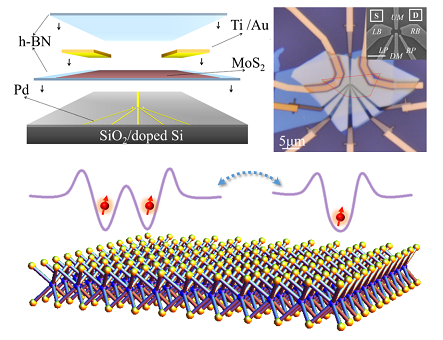
Combined with 2-D materials, quantum dots, very small semiconductor particles, can be used to deeply investigate rich physics down to the single-particle level. Because of their outstanding electronic properties, compatibility with large-scale production, atomically thin 2-D materials, represented by graphene, expand the scope of flexible electronics and quantum electronic studies.
Since the discovery of graphene in 2004, many experiments have been done on these materials. However, the band structure of graphene and impurities at interfaces and edges severely limit the performance of quantum dot devices. Up to now, quantum dot in 2D materials cannot be well controlled electrically.
Professor GUO Guoping's group at University of Science and Technology of China (USTC) of Chinese Academy of Sciences, collaborating with researchers from Japanese research institutes, achieved great progress in semiconductor quantum dot by discovering the possible applications of transition metal dichalcogenides. They experimentally demonstrated a fully electrotunable double quantum dot device based on semiconducting flexible 2D materials for the first time. The results were published as in Science Advances.
Chinese scientists, together with Japanese scientists from National Institute for Material Sciences and Institute of Physical and Chemical Research, Japan, chose novel 2D material molybdenum disulfide (MoS2) to perform the experiments. With vast application prospect in quantum electronics, especially in spintronics and valleytronics, MoS2 has appropriate band gap, suitable spin-orbit coupling strength and rich valley-spin physics.
Using nanofabrication, low-temperature LED illumination and many semiconductor industry-level techniques, as well as hexagonal boron nitride encapsulation technique, the joint group effectively reduced the impurities and disorders in the quantum dot structure, and achieved fully electrotunable double quantum dot architecture in 2D materials for the first time.
At low temperatures, by tuning of gate voltages applied to the electrodes, they can tune a large quantum dot with a width of 128 nm into a double quantum dot, consisting of two 68-nm coupled single quantum dots. The interdot single-electron tunneling event can be tuned monotonically using the gate voltage, which means the electrically controllable evolution between artificial molecule and artificial atom was achieved.
Such kind of controllable single-electron tunneling transistors provided a powerful platform to study spin-valley physics in these materials at single-particle level. Using this platform, the group observed a physical phenomenon called Coulomb blockade weak anti-localization, indicating the effects of short-range disorders and spin-orbit couplings on electronic transport properties in MoS2.
This work is supported by the National Natural Science Foundation of China, Ministry of Science and Technology of China, Chinese Academy of Sciences, Synergetic Innovation Center of Quantum Information & Quantum Physics, and the USTC Center for Micro and Nanoscale Research and Fabrication.

Figure: Sample images and schematics of the experiment (Image by GUO Guoping)

86-10-68597521 (day)
86-10-68597289 (night)

52 Sanlihe Rd., Xicheng District,
Beijing, China (100864)

